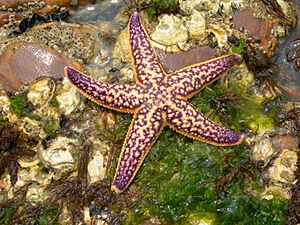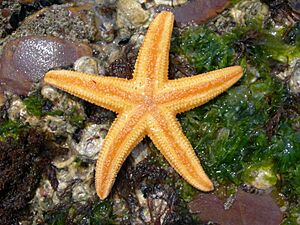Northern Pacific seastar in Australia facts for kids
The Northern Pacific seastar (Asterias amurensis) is an unwanted sea creature in Australia. It is known as an invasive species in Australia because it causes problems for local marine life.
Contents
Where Did This Seastar Come From?
This seastar naturally lives along the coasts of northern China, North Korea, South Korea, Russia, and Japan. Over time, it has spread to many other countries. It's even on a special list of the world's 100 worst invasive species!
How It Spreads
These seastars can travel around the world in different ways. They can move through seawater used in the live fish trade, on recreational boats, in ballast water (water ships take in for balance), and even stuck to the bottoms of ships.
This species likes water temperatures between 7°C and 10°C. However, it has managed to live in Australian waters, which can be around 22°C. You usually find them in shallow, protected coastal areas. They can handle many different temperatures and levels of salinity (saltiness). This means they are often found in estuaries (where rivers meet the sea) and on muddy, sandy, or rocky sheltered areas between high and low tide.
Finding the Seastar in Australia
The Asterias amurensis was first spotted in Tasmanian coastal waters in 1986. Since then, it has been found from Banks Strait in the north down to Recherche Bay in the south. The biggest groups of them live in sheltered waters in south-east Tasmania, especially in the Derwent Estuary.
From Tasmania, it spread north and was found in Port Philip Bay, Victoria. In just two years, its numbers there grew to about 12 million! It is now a permanent resident in that area. It has also been seen in other places like San Remo, Anderson Inlet, Waratah Bay, Tidal River, and the Gippsland Lakes area. People are working hard to stop them from settling in these new spots.
What It Eats and How It Reproduces
In Australian waters, these seastars lay their eggs between July and October. A female seastar can produce an amazing 10 to 25 million eggs!
This seastar is a very hungry hunter. It eats many different sea creatures. These include bivalves (like clams and mussels), snails, barnacles, crustaceans (like crabs), sea worms, echinoderms (like sea urchins), and sea squirts. It even eats other seastars, including its own kind, if it runs out of other food. Its favorite foods are clams, mussels, and scallops. It will also eat dead fish and fish waste.
Even though it prefers shallow, sheltered places, this seastar has also been seen in other homes. These include rocky reefs and solid rock. In its native home around Japan, it can live in waters as deep as 200 meters (about 650 feet).
Why This Seastar is a Problem
The Northern Pacific seastar is a serious problem for Australia's native marine animals. It is a big reason why the critically endangered spotted handfish is disappearing. This seastar eats the handfish eggs. It also eats the sea squirts that the handfish need to lay their eggs on.
It is also a problem for mariculture (sea farming). It settles on the ropes and cages used to grow scallops, mussels, and oysters, as well as in salmon cages. This makes it harder for farmers to grow their seafood.
In 2005, a study found that Asterias amurensis was "one of the ten most damaging potential species" for Australia. This was based on how much harm it could cause to both the economy and the environment.
How People Are Trying to Control It
This seastar is listed on the National Introduced Marine Pest Coordinating System (NIMPIS). This website shares information about marine pests that are already in Australia or could arrive in the future.
A. amurensis is on Australia’s Priority Marine Pest List. In 2019, it was named an Australian pest species of national importance. This is because of its bad effects on aquaculture (sea farming), commercial shellfish industries, and the critically endangered spotted handfish.
Natural Helpers
In Australia, only one native animal has been seen eating this seastar in the wild. This is the native spider crab (Leptomithrax gaimardii) in the Derwent Estuary. However, lab tests showed that another seastar, Coscinasterias muricata, eats smaller Northern Pacific seastars. Scientists are looking into whether this could be a way to control new groups of the seastar in Victoria.
Other Control Methods
Scientists have found that putting the seastar larvae (baby seastars) in freshwater can kill them. This might be a way to control them. People have also suggested catching and selling the seastars where there are many of them. However, there are problems with this idea, like not having a market for the fertilizer made from them.
Other methods that have been thought about or tried include dredging (scooping them up from the seafloor), using quicklime (a chemical) to poison them, netting, trapping, and picking them up by hand. But none of these methods have worked well for various reasons. The public is asked to report any sightings of this seastar to the authorities.
Marine biologists hope that in the future, they might be able to introduce diseases or sterile (unable to have babies) seastars to help control the population.
Volunteer Efforts
Volunteer divers have been trying to reduce the number of seastars in Tasmania's Derwent River since they first arrived. In 1993, volunteers collected over 30,000 seastars. However, many of the seastars were cut up and thrown back into the sea. Later, it was discovered that each piece could grow into a new seastar, as long as it had part of its central body.
As of As of 2021[update], a new effort is being led by a local diver named Benni Vincent. He plans to organize two to three dives a month for three to five years. They will focus on areas where there are many seastars and where the handfish live.



